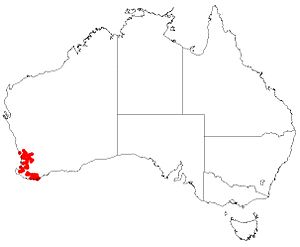Little kangaroo paw facts for kids
Quick facts for kids Little Kangaroo Paw |
|
|---|---|
 |
|
| Scientific classification | |
| Genus: |
Anigozanthos
|
| Species: |
bicolor
|
 |
|
| Distribution of collections of Anigozanthos bicolor species from Australia's Virtual Herbarium | |
The Little Kangaroo Paw, also known as the Two-coloured Kangaroo Paw, is a special plant from Western Australia. Its scientific name is Anigozanthos bicolor. It looks a bit like grass, but it's a perennial herb. This means it's not a tree or a bush, and it lives for more than two years, coming back each growing season. You can find it growing naturally along the southwestern coast of Australia.
Contents
What is a Little Kangaroo Paw?
This interesting plant grows from a special underground stem called a rhizome. A rhizome is like a root that grows sideways, helping the plant spread. The Little Kangaroo Paw usually grows to be about 5 centimeters (2 inches) to 60 centimeters (2 feet) tall.
When Does It Bloom?
The plant shows off its beautiful flowers in spring. This happens between August and October in Australia. Its flowers are quite colourful, often a mix of green, yellow, and red. They look a bit like a kangaroo's paw, which is how the plant got its common name!
How Scientists Name Plants
Every plant has a unique scientific name, just like people have first and last names. This helps scientists all over the world know exactly which plant they are talking about.
The Discovery of Anigozanthos bicolor
The Little Kangaroo Paw was first officially described in 1846. A botanist named Stephan Endlicher gave it its scientific name. This was part of a bigger project by Johann Georg Christian Lehmann called Plantae Preissianae.
Different Names for the Same Plant
Sometimes, a plant might have a few different scientific names over time. These are called synonyms. For the Little Kangaroo Paw, its only other names that were used are Agonizanthos bicolor and Anigosanthus bicolor. But Anigozanthos bicolor is the correct and accepted name today.
What are Subspecies?
Within one plant species, there can be slightly different groups called subspecies. They are still the same main plant, but they have small differences, often because they grow in different places. The Little Kangaroo Paw has four known subspecies:
- Anigozanthos bicolor Endl. subsp. bicolor
- Anigozanthos bicolor subsp. decrescens (described by Stephen Hopper in 1987)
- Anigozanthos bicolor subsp. exstans (described by Stephen Hopper in 1987)
- Anigozanthos bicolor subsp. minor (described by Stephen Hopper in 1987)
Where Does It Grow?
The Little Kangaroo Paw is found along the west coast of Western Australia. You can see it from places like Northam and Moora in the north, all the way down to Albany in the south.
Its Habitat
It also grows in some areas further east along the south coast, reaching as far as Cape Arid. It doesn't grow everywhere in a continuous line; its distribution is "discontinuous," meaning it pops up in different spots.
This plant likes to grow in damp areas, especially places that get wet in winter. You might also find it near large granite rocks or along the sides of roads. It can grow in different types of soil, including clay, loam (a mix of sand, silt, and clay), or sandy soils. These soils often sit on top of granite or laterite (a type of reddish soil). The Little Kangaroo Paw is usually part of open forest or low heathland communities, which are types of natural plant groups.

